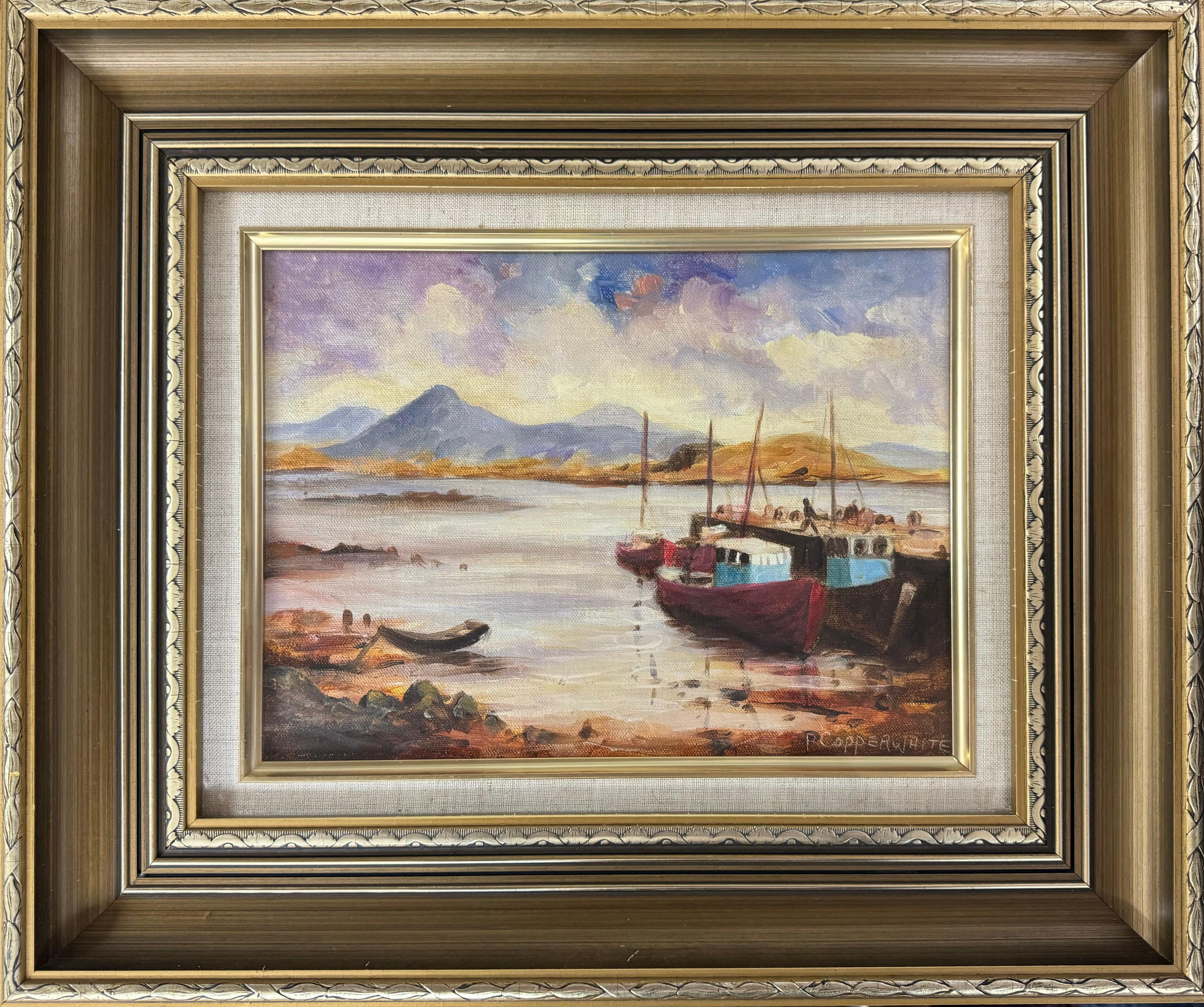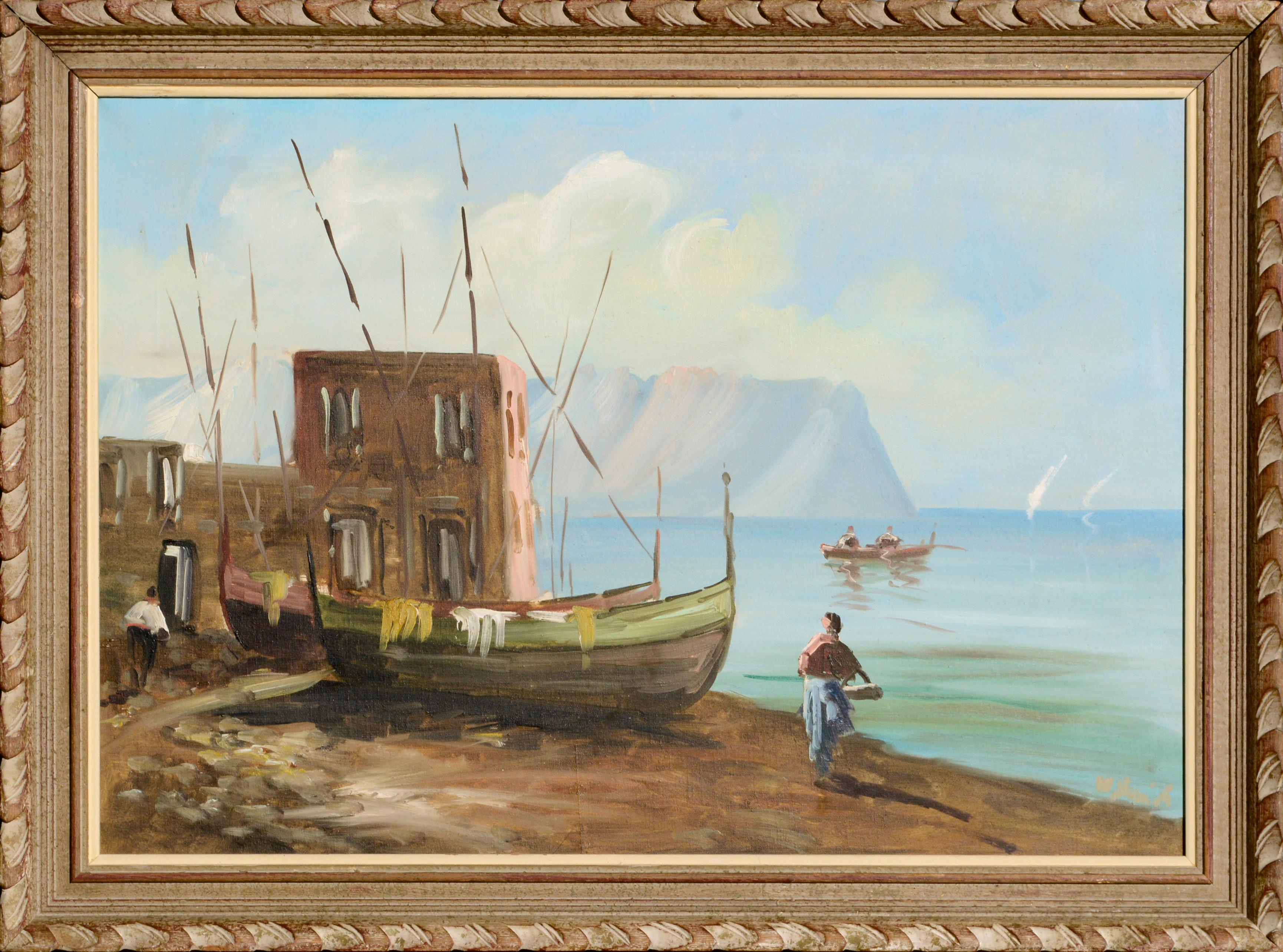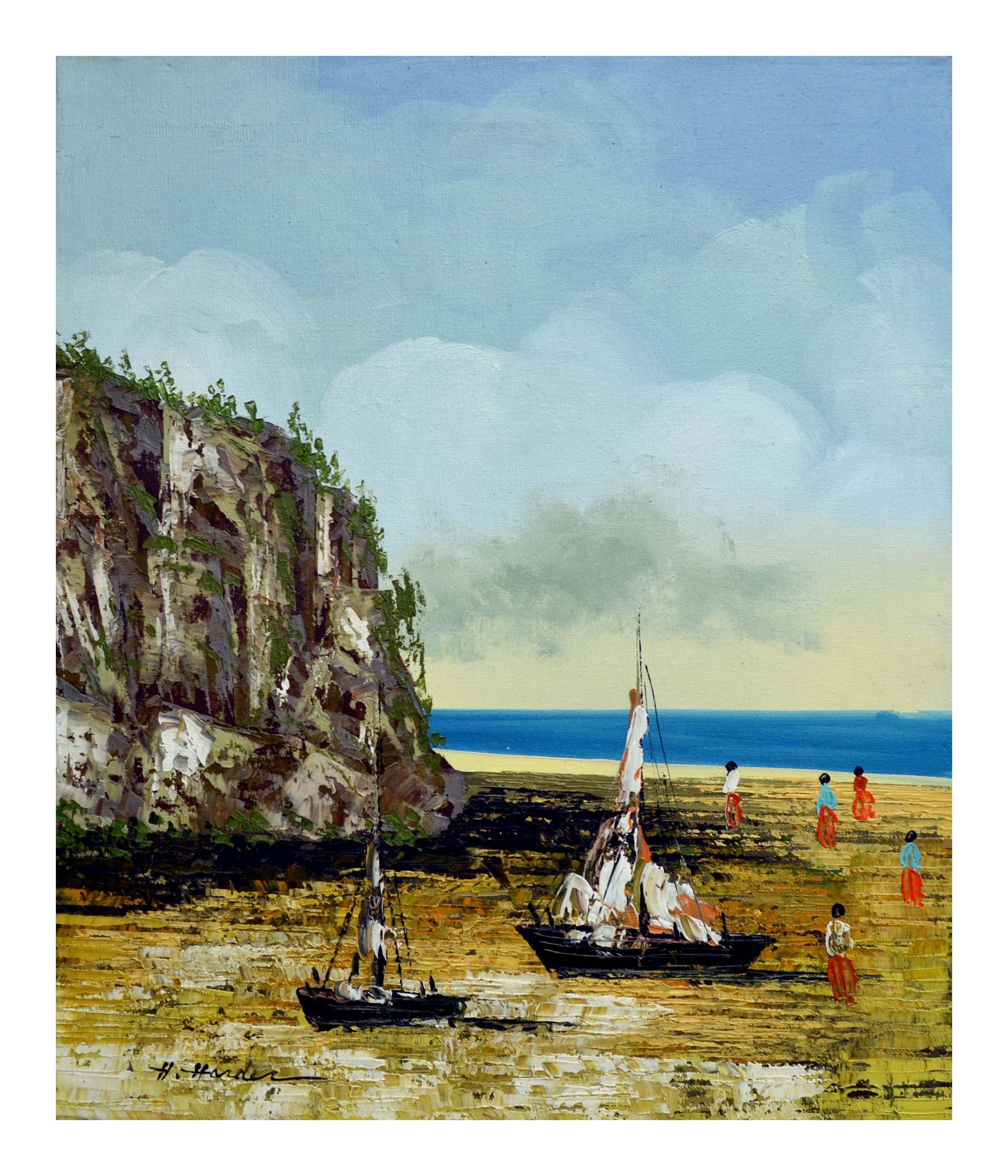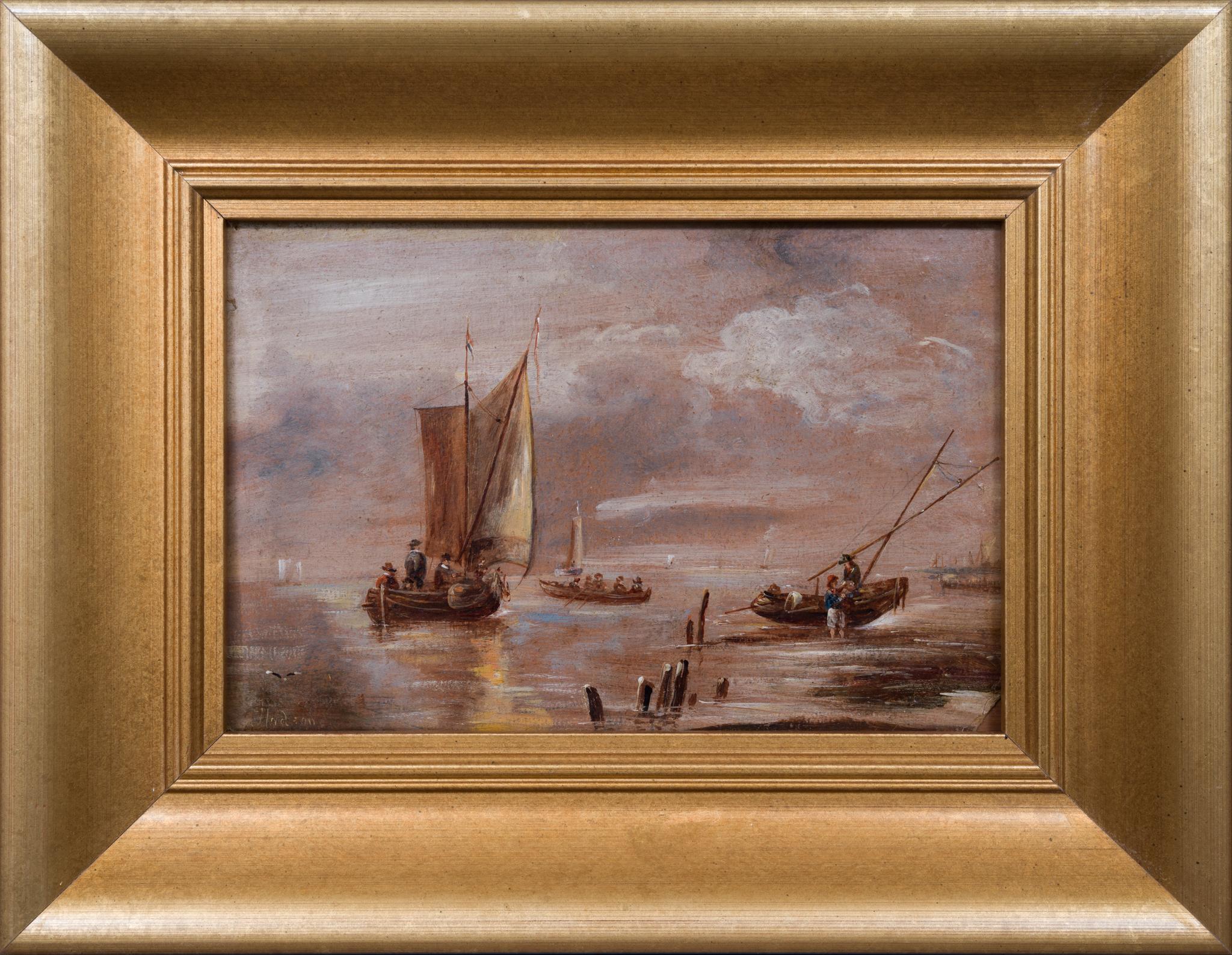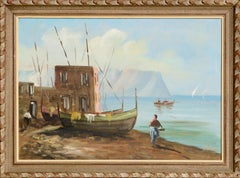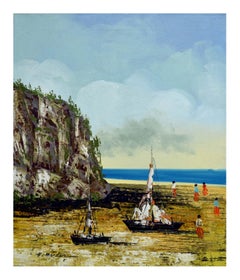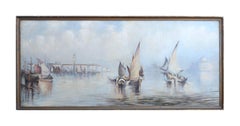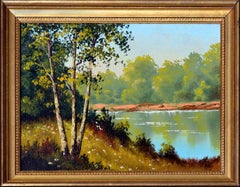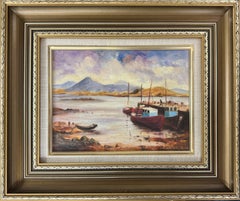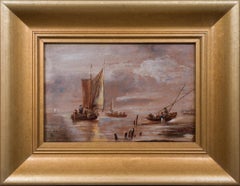Items Similar to Boat at the Shore, Minimalist Landscape
Want more images or videos?
Request additional images or videos from the seller
1 of 11
UnknownBoat at the Shore, Minimalist Landscape1969
1969
$940
$1,17520% Off
£711.43
£889.2920% Off
€816.87
€1,021.0920% Off
CA$1,339.11
CA$1,673.8920% Off
A$1,452.29
A$1,815.3720% Off
CHF 762.80
CHF 953.5020% Off
MX$17,640.67
MX$22,050.8420% Off
NOK 9,545.24
NOK 11,931.5520% Off
SEK 8,987.37
SEK 11,234.2220% Off
DKK 6,098.49
DKK 7,623.1120% Off
About the Item
Minimalist landscape of a boat pulled up to the shore, a simple dwelling nearby and mountains in the background, by an unknown artist, 1969. Signed lower left corner with the monogram "O," an indistinct signature and the year "69." Displayed in a rustic wood frame with linen covered wood liner. Image, 24"H x 32"W.
- Creation Year:1969
- Dimensions:Height: 32 in (81.28 cm)Width: 40 in (101.6 cm)Depth: 2 in (5.08 cm)
- Medium:
- Movement & Style:
- Period:
- Condition:Vintage frame and liner show wear consistent with age.
- Gallery Location:Soquel, CA
- Reference Number:Seller: JT-S3868*1stDibs: LU5422300903
About the Seller
5.0
Platinum Seller
Premium sellers with a 4.7+ rating and 24-hour response times
Established in 1986
1stDibs seller since 2014
3,010 sales on 1stDibs
Typical response time: <1 hour
- ShippingRetrieving quote...Shipping from: Soquel, CA
- Return Policy
Authenticity Guarantee
In the unlikely event there’s an issue with an item’s authenticity, contact us within 1 year for a full refund. DetailsMoney-Back Guarantee
If your item is not as described, is damaged in transit, or does not arrive, contact us within 7 days for a full refund. Details24-Hour Cancellation
You have a 24-hour grace period in which to reconsider your purchase, with no questions asked.Vetted Professional Sellers
Our world-class sellers must adhere to strict standards for service and quality, maintaining the integrity of our listings.Price-Match Guarantee
If you find that a seller listed the same item for a lower price elsewhere, we’ll match it.Trusted Global Delivery
Our best-in-class carrier network provides specialized shipping options worldwide, including custom delivery.More From This Seller
View AllBoats on the Shore - Figurative Landscape
Located in Soquel, CA
Continental seascape of fishing boats and the shore with ocean cliffs in the background by an unknown artist. Signed (illegible) in the lower right corner. Presented in a painted and...
Category
Late 20th Century Impressionist Landscape Paintings
Materials
Canvas, Oil
$703 Sale Price
20% Off
Mid Century Boats at Sea Landscape
Located in Soquel, CA
Gorgeous mid century oil on canvas painting of boats on the beach by Henry Harder (American, 20th c.), circa 1960. Signed "H. Harder" bottom right. Unframed.
Category
1960s Impressionist Landscape Paintings
Materials
Canvas, Oil
$320 Sale Price
20% Off
1920's Boats on the Nile Landscape
Located in Soquel, CA
Beautiful seascape oil painting of boats sailing on the Nile, showing the city in the background by an unknown artist, c.1920. Unsigned. Rustic frame. Image, 20"H x 44"W.
Category
Early 20th Century Romantic Landscape Paintings
Materials
Canvas, Oil
$1,400 Sale Price
20% Off
Mid Century Serene Lakeside Landscape
Located in Soquel, CA
Serene mid century lakeside landscape by an unknown artist (American, 20th Century). Presented in a rustic giltwood frame. Image: 9"H x 12"W. Framed: 11.25"H x 14.25"W.
Excellent w...
Category
1960s American Modern Landscape Paintings
Materials
Canvas, Oil, Illustration Board
Mountain Lake Landscape with Boats
Located in Soquel, CA
Beautiful watercolor landscape in a palette of deep greens and blues, of a boat pulled up on a lake shore with layered tree lines in the background Signed "E. P. Blackburn" lower ri...
Category
1990s American Impressionist Landscape Drawings and Watercolors
Materials
Watercolor, Archival Paper
$320 Sale Price
20% Off
Mid Century Figurative Seascape with Sailboats
By Henryk Dzienczarski
Located in Soquel, CA
Mid-century figurative seascape with boats by Henryk Dzienczarski, (Poland, b-1917). Signed "H. Dzienczarski" lower right. Displayed in a wood fra...
Category
1950s Post-Impressionist Landscape Paintings
Materials
Oil, Illustration Board
$439 Sale Price
20% Off
You May Also Like
Boats on the bay
Located in Cliffside Park, NJ
Part of the set, please look in my storefront.
Pat built his own studio/gallery onto their home. He did a great deal of work there, but much prefered to paint outdoors, especially ...
Category
20th Century Landscape Paintings
Materials
Oil
Landscape with Boats
By Mario Montilus
Located in San Francisco, CA
This artwork "Landscape with Boats" 1987, is an acrylic painting on canvas by noted Haitian artist Mario Montilus, b.1961. It is signed at the low...
Category
Late 20th Century Other Art Style Landscape Paintings
Materials
Acrylic
Idyllic Landscape
Located in Douglas, Isle of Man
In the manner of Jean-Francoise Milet, 1814-1875, was a French artist, and one of the founders of the Barbizon School of painters. Milet influenced a great many painters throughout ...
Category
Late 20th Century Landscape Paintings
Materials
Canvas, Oil
Maritime Scene with Sailboats
Located in Stockholm, SE
This captivating maritime painting, likely the work of an English artist, dates to the late 19th century and showcases a masterful command of light and texture. The composition featu...
Category
Late 19th Century Romantic Figurative Paintings
Materials
Oil, Board
Vintage Lakeside Landscape
Located in Douglas Manor, NY
6045 Vintage oversized lakeside landscape. Framed Image size 18.5x29.5
Signed lower left 1971
Category
1970s Landscape Paintings
Materials
Oil
Sailboat on the Lake
Located in San Francisco, CA
This artwork "Sailboat on the Lake" c.1940 is an oil painting on canvas board Attributed to German artist Otto Krone 1874-1957. It is signed at the lower left corner. The canvas boar...
Category
Mid-20th Century Impressionist Landscape Paintings
Materials
Oil
More Ways To Browse
Place De Concorde Painting
Rene Menard
Robert Stone Painting
Russian Impressionism
Shipwreck Painting
Suzanne Crochet
Texas Longhorn Vintage
William Goliasch
1993 Kelly
19th Century Landscape Moonlight
Alaska Painting
Anglada Camarasa
Antique Horse Plough
Anton Mauve
Betty Blue
British Landscape Female Artist
Brooks Anderson
California Flowers Painting
